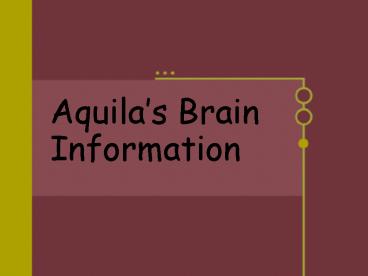Aquilas Brain Information PowerPoint PPT Presentation
1 / 44
Title: Aquilas Brain Information
1
Aquilas Brain Information
2
- mid-brain and pons.
3
mid-brain and pons
- Pons means bridge.
- The mid-brain is the highest on the brain
- stem.
- It is involved in motor control and sensory
analysis. - It controls many automatic functions.
- It sifts millions of signals sent to the brain
every second from the rest of your body.
4
- cerebellum
5
- Cerebrum
6
- The brainstem
7
- The midbrain is the highest point on the
- brainstem and helps our eyes adjust to light
and our ears to hear sound. - The brainstem is about 3 inches long,
- and has 3 parts, the midbrain, the pons, and
the medulla.
8
- Pons or bridge sends messages between thbrain
and the spinal cord to tell us when to wale k. - The brainstem is also known as the reptilian
brain, because it is the oldest - thinking part of the brain.
9
- The medulla is in the top of the spine and
controls all the automatic functions of our body
like heartbeat, digestion, breathing, swallowing
and blood pressure.
10
- The Limbic System
11
- Lobes and cranium
12
The Cranium
- Your brain
13
Frontal lobe
- Located in front of the central sulcus.
- Damage can result mood changes.
14
Parietal lobe
- Located behind the central sulcus.
15
Temporal lobe
- The temporal lobe is important to the
- Senses of smell and sounds.
16
Occipital lobe
- Concerned with many aspects of visions.
17
The Cranium
- At birth the cranium is not fully formed.
- Your brain continues to grow until you are seven
years old. - Your skull is made up of twenty/eight bones.
18
- Thalamus
19
- The Thalamus is the first stop for sensory
messages. - Sensory messages are pain,pressure, and
temperature.
20
- The Thalamus knows that you are getting hurt but
does not know where the pain is coming from!
21
- For example,if you put your hand over a flame,the
message goes from the thalamus to the cerebral
cortex down the spinal cord and tells the hand to
move.
22
- Thalamus means inner room in Latin. Your
Thalamus is located in the middle of tour brain
and looks like an egg.
23
- If you spilt the brain in half both the left and
right hemispheres would each get a half of the
thalamus.
24
- The thalamus regulates sleep cycles and
wakefulness. - It also seems to help you feel if you are in a
good mood or a bad mood.
25
- The Hypothalamus
26
- The Medulla Oblongata
27
Medulla Oblongata
- The Medulla Oblongata is approximately. 3 cm
Long. - The Medulla Oblongata houses nerve
- Centers that control breathing, heart rate,
- Blood pressure, swallowing, and other
- Important functions.
28
Medulla Oblongata
- The Medulla is one of four major parts
- Of the brainstem.
- The Medulla contains nerve cells that
- Go up, and nerve cells that go down.
- The Medulla is at the lowest part of
- The brainstem.
29
Size of the Hypothalamus
- The Hypothalamus is slightly larger than a red
kidney bean. - It weighs -1/300of the whole brain (4 grams).
- It can do more per unit weight than any other
part of the brain.
30
Location of the Hypothalamus
- The Hypothalamus(hypo-under and thalamus-inner
room) is located between the two cerebral
hemispheres-diencephalaons. - It is the inferior portion of the diencephalons.
31
Controls and prepares you to handle emotions
- Limbic system-a group of structures deep in the
fore brain involved with emotional behavior. - Controls and prepares you to handle emotions such
as hunger,thirst,fear and happiness. - Controls the level of alertness such as sleeping
and waking.
32
Monitoring the blood
- The Hypothalamus is on a 24 hour blood alert.
- It constantly monitors the blood to make sure it
has everything it needs. - It is directly responsible for innate biological
drives most fundamental to survival.
33
Hunger pangs
- You get energy from food.
- Food breaks down into sugar and blood carries it
to different parts of the body
34
Water works and waste
- It is important to have the right amount of water
in the blood. - Kidneys act as filters.
35
Maintains the body temperature
- It helps keep your body temperature at about 98.6
F even if it is cold or hot outside. - When your body becomes overheated the
Hypothalamus stimulates your sweat glands to
produce perspiration which comes through the
pores that evaporates to cool your skin.
36
Oxygen uptake
- All parts of your body need oxygen.
- Blood carries oxygen all over the body.
- You need more oxygen than usual when you work
hard like running up a steep hill.
37
Functions of the hypothalamus
- The hypothalamus is the most fascinating area of
the brain. - brain within the brain.
- It is a important central monitor for many
functions.
38
The hormonal and Nervous system
- Controls the pituitary or master gland.
- It is the link between two major systems of the
body -brain and nerves and the hormonal or
endocrine system.
39
Cerebral CortexBy Duncan Raynor
40
- The gyri are the parts of the cerebral cortex you
see on a brain and the sulci are the parts of the
cerebral cortex that are folded under the gyri.
41
- The cerebral cortex is like the main control
center of thinking, learning, remembering and
planning.
42
- The cortex, which means bark, covers the brain
like bark might cover a tree.
43
- There are about 50 billion nerve cells in the
cerebral cortex.
44
- The cerebral cortex is not very colorful. It is
made up of mostly pinkish-gray nerve cells.

